GE DPXH46, DH43, DSXH43, PSXH43 User Manual
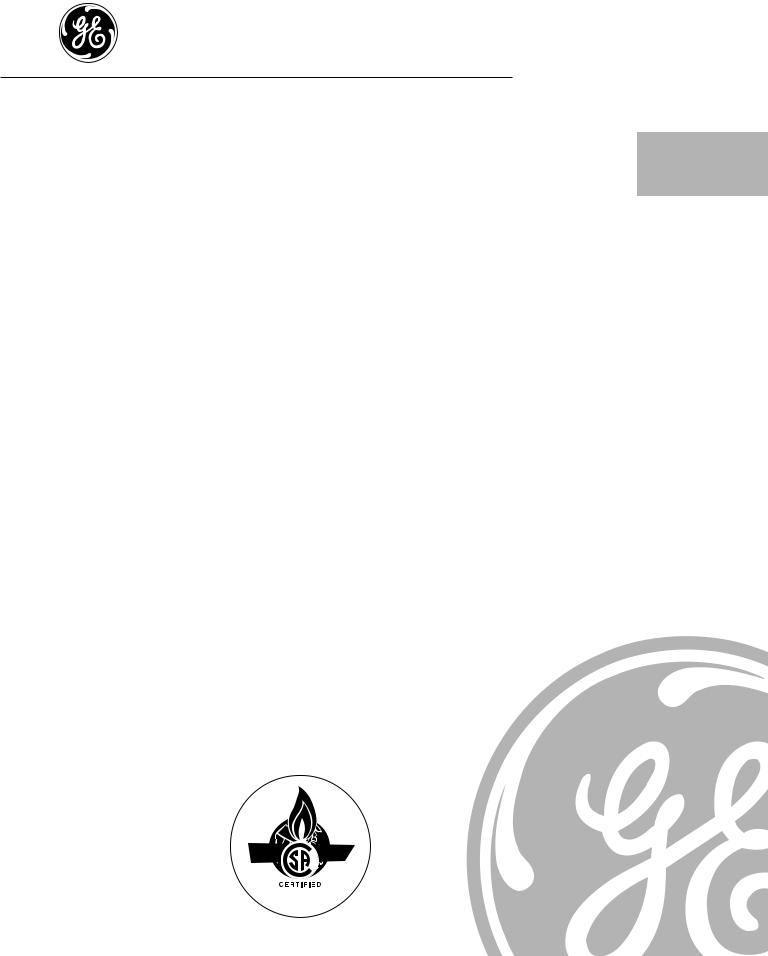
DryersSpacemaker
GE Appliances
Safety Information . . . . . . . . . . . . . 3–5
Operating Instructions
Care and Cleaning . . . . . . . . . . . . . . . . .8
Controls . . . . . . . . . . . . . . . . . . . . . . . . . . 6
Features . . . . . . . . . . . . . . . . . . . . . . . . . .7
Loading and Using
the Dryer . . . . . . . . . . . . . . . . . . . . . . . . .8
Installation Instructions
Electrical Installation for
Electric Dryer . . . . . . . . . . . . . . . . . 16, 17 Electrical Requirements . . . . . . . . . . .11 Exhausting the Dryer . . . . . . . . . . .12, 13 Gas Connection for Gas Dryer . . . . . .18 Gas Supply Requirements . . . . . . . . . .13 Location of Your Dryer . . . . . . . . . . . .14 Mobile Home Installation . . . . . . . . . .15 Preparing to Install Your Dryer . . .9, 10 Reversing the Door Swing . . . . . . . . . .20 Stacking Instructions . . . . . . . . . . .19, 20
Troubleshooting Tips . . . . . . . .21, 22
Customer Service
Service Telephone
Numbers . . . . . . . . . . . . . . . . Back Cover Warranty for U.S. Customers . . . . . . . 24 Warranty for Canadian Customers . .25
Owner’s Manual
and Installation
Instructions
DSXH43
DPXH46
DH43
PSXH43
www.geappliances.com |
175D1807P324 49-90059 07-00 JR |
350A4502P188 131960700
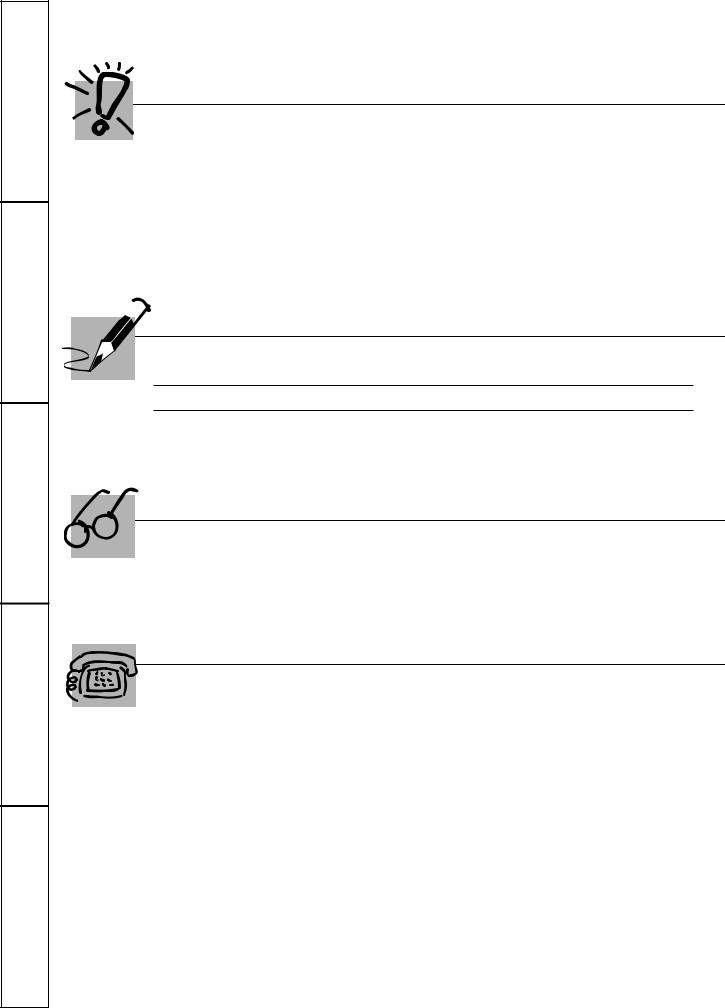
TroubleshootingTips InstallationInstructions OperatingInstructions SafetyInstructions
CustomerService
GE & You, A Service Partnership.
 IMPORTANT!
IMPORTANT!
 Staple sales slip or cancelled check here.
Staple sales slip or cancelled check here.
Proof of the original purchase date is needed to obtain service under the warranty.
Fill out the Consumer Product Registration Card.
Two easy ways to register your appliance!
■Through the internet at www.geappliances.com
■Complete and mail the enclosed Product Registration Card
 FOR YOUR RECORDS
FOR YOUR RECORDS
Write the model and serial numbers here:
#
#
They are on the label on the left side of the door opening.
READ THIS MANUAL
Inside you will find many helpful hints on how to use and maintain your dryer properly. Just a little preventive care on your part can save you a great deal of time and money over the life of your dryer.
IF YOU NEED SERVICE
You’ll find many answers to common problems in the Before You Call For Service section. If you review our chart of Troubleshooting Tips first, you may not need to call for service at all.
If you do need service, you can relax knowing help is only a phone call away. A list of toll-free customer service numbers is included in the back section.
OR
Visit our Website at: www.geappliances.com
2
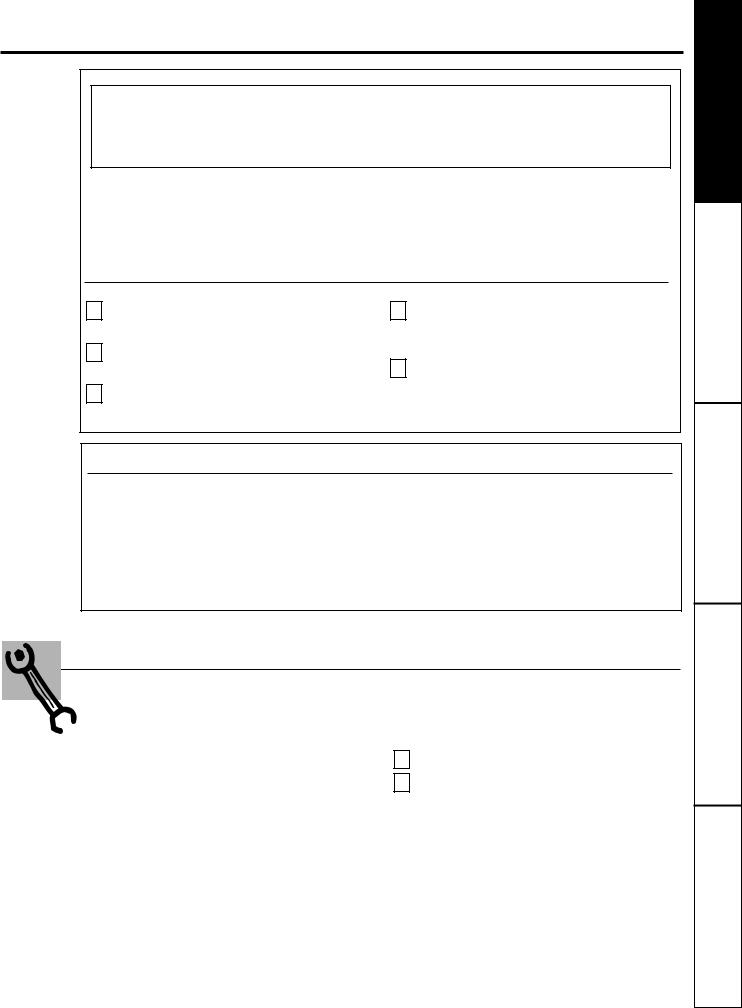
IMPORTANT SAFETY INFORMATION.
READ ALL INSTRUCTIONS BEFORE USING.
 WARNING!
WARNING!
For your safety, the information in this manual must be followed to minimize the risk of fire or explosion, electric shock, or to prevent property damage, personal injury, or death.
■ Do not store or use gasoline or other |
■ Installation and service must be performed |
flammable vapors and liquids in the |
by a qualified installer, service agency or |
vicinity of this or any other appliance. |
the gas supplier. |
|
|
WHAT TO DO IF YOU SMELL GAS:
1
2
3
Do not try to light a match, or cigarette, or turn on any gas or electrical appliance.
Do not touch any electrical switch; do not use any phone in your building.
Clear the room, building or area of all occupants.
4
5
Immediately call your gas supplier from a neighbor’s phone. Follow the gas supplier’s instructions carefully.
If you cannot reach your gas supplier, call the fire department.
California Safe Drinking Water and Toxic Enforcement Act
This act requires the governor of California to publish a list of substances known to the state to cause cancer, birth defects or other reproductive harm and requires businesses to warn customers of potential exposure to such substances.
Gas appliances can cause minor exposure to four of these substances, namely benzene, carbon monoxide, formaldehyde and soot, caused primarily by the incomplete combustion of natural gas or LP fuels.
Properly adjusted dryers will minimize incomplete combustion. Exposure to these substances can be minimized further by properly venting the dryer to the outdoors.
PROPER INSTALLATION
This dryer must be properly installed and located in accordance with the Installation Instructions before it is used.
■Properly ground dryer to conform with all governing codes and ordinances. Follow details in Installation Instructions.
■Install or store where it will not be exposed to temperatures below freezing or exposed to the weather.
■Connect to a properly rated, protected and sized power supply circuit to avoid electrical overload.
■Remove all sharp packing items and dispose of all shipping materials properly.
Exhaust/Ducting:
1 This dryer MUST be exhausted to the outside.
2 Use only rigid metal or flexible metal 4″ diameter ductwork inside the dryer cabinet or for exhausting to the outside. USE OF
PLASTIC OR OTHER COMBUSTIBLE DUCTWORK CAN CAUSE A FIRE. PUNCTURED DUCTWORK CAN CAUSE A FIRE IF IT COLLAPSES OR BECOMES OTHERWISE RESTRICTED IN USE OR DURING INSTALLATION.
For complete details, follow the Installation Instructions.
3
Tips Troubleshooting Instructions Installation Instructions Operating Instructions Safety
Service Customer
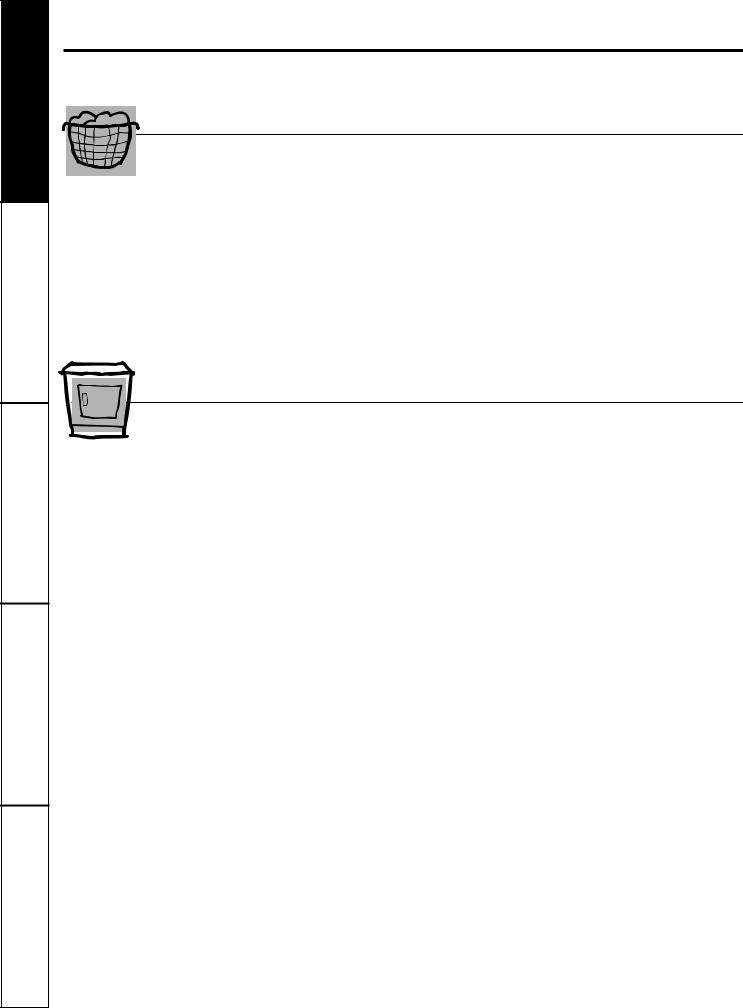
TroubleshootingTips InstallationInstructions OperatingInstructions Safety Instructions
CustomerService
IMPORTANT SAFETY INFORMATION. READ ALL INSTRUCTIONS BEFORE USING.
 WARNING!
WARNING!
YOUR LAUNDRY AREA
■Keep the area underneath and around your appliances free of combustible materials, such as lint, paper, rags, chemicals, etc.
■Keep the floor around your appliances clean and dry to reduce the possibility of slipping.
■Keep area around the exhaust opening and surrounding areas free from the accumulation of lint, dust and dirt.
■Do not obstruct the flow of ventilating air. Do not stack or place laundry or throw rugs against the front or back of the dryer.
■Close supervision is necessary if this appliance is used by or near children. Do not allow children to play on, with, or inside this or any other appliance.
■Keep all laundry aids (such as detergents, bleaches, etc.) out of the reach of children, preferably in a locked cabinet. Observe all warnings on container labels to avoid injury.
■Never climb on or stand on the dryer top.
WHEN USING YOUR DRYER
■Never reach into the dryer while the drum is moving. Before loading, unloading or adding clothes, wait until the drum has completely stopped.
■Clean the lint filter before each load to prevent lint accumulation inside the dryer or in the room.
DO NOT OPERATE THE DRYER WITHOUT THE LINT FILTER IN PLACE, UNLESS THE DRYING RACK IS IN USE. Always replace the lint screen when finished using the drying rack.
■Do not wash or dry articles that have been cleaned in, washed in, soaked in, or spotted
with combustible or explosive substances (such as wax, oil, paint, gasoline, degreasers, dry-cleaning solvents, kerosene, etc.) which may ignite or explode. Do not add these substances to the wash water. Do not use or place these substances around your washer or dryer during operation.
■Any article on which you have used a cleaning solvent or that contains flammable materials (such as cleaning cloths, mops, towels used in beauty salons, restaurants, or barber shops, etc.) must not be placed in or near the dryer until solvents or flammable materials have been removed. There are many highly flammable items used in homes such as acetone, denatured alcohol, gasoline, kerosene, some household cleaners, some spot removers, turpentines, waxes, wax removers and products containing petroleum distillates.
■The laundry process can reduce the flame retardancy of fabrics. To avoid such a result, carefully follow the garment manufacturer’s care instructions.
■Do not dry articles containing rubber, plastic, or similar materials such as padded bras, tennis
shoes, galoshes, bath mats, rugs, bibs, baby pants, plastic bags, pillows, etc. that may melt or burn. Some rubber materials, when heated, can under certain circumstances produce fire by spontaneous combustion.
■Do not store plastic, paper or clothing that may burn or melt on top of the dryer during operation.
■Garments labeled Dry Away from Heat or Do Not Tumble Dry (such as life jackets containing Kapok) must not be put in your dryer.
■Do not dry fiberglass articles in your dryer. Skin irritation could result from the remaining particles that may be picked up by clothing during subsequent dryer uses.
■To minimize the possibility of electric shock, unplug this appliance from the power supply or disconnect the dryer at the household distribution panel by removing the fuse or switching off the circuit breaker before attempting any maintenance or cleaning (except the removal and cleaning of the lint filter). NOTE: Turning the Cycle Selector knob to an OFF position does NOT disconnect the appliance from the power supply.
■Do not spray any type of aerosol into, on or near dryer at any time.
■Do not place items exposed to cooking oils in your dryer. Items contaminated with cooking oils may contribute to a chemical reaction that could cause a clothes load to catch fire.
4
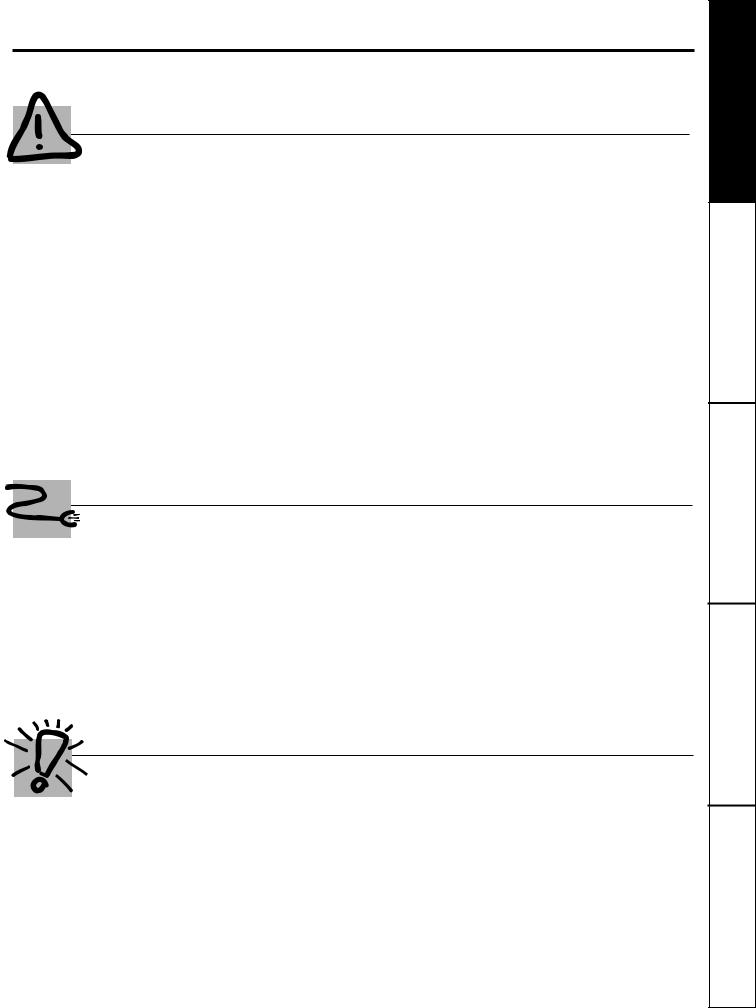
WARNING!
■Never attempt to operate this appliance if it is damaged, malfunctioning, partially
disassembled, or has missing or broken parts, including a damaged cord or plug.
■The interior of the machine and the exhaust duct connection inside the dryer should be cleaned at least once a year by a qualified technician. See the
Loading and Using the Dryer section. Do not use any type of spray cleaner when cleaning dryer interior. Hazardous fumes or electrical shock could occur.
■If yours is a gas dryer, it is equipped with an automatic electric ignition and does not have a pilot light. DO NOT ATTEMPT TO LIGHT WITH A MATCH. Burns may result from having your hand in the vicinity of the burner when the automatic ignition turns on.
■You may wish to soften your laundered fabrics or reduce the static electricity in them by using a dryer-applied fabric softener or an anti-static conditioner. We recommend you use either a
fabric softener in the wash cycle, according to the manufacturer’s instructions for those products, or try a dryer-added product for which the manufacturer gives written assurance on the package that their product can be safely used in your dryer. Service or performance problems caused by use of these products are the responsibility of the manufacturers of those products and are not covered under the warranty to this appliance.
WHEN NOT USING YOUR DRYER
■Grasp the plug firmly when disconnecting this appliance to avoid damage to the cord while pulling. Place the cord away from traffic areas so it will not be stepped on, tripped over or subjected to damage.
■Do not attempt to repair or replace any part of this appliance or attempt any servicing unless specifically recommended in this Owner’s Manual or in published user-repair instructions that you understand and have the skills to carry out.
■Before discarding a dryer, or removing it from service, remove the dryer door to prevent children from hiding inside.
■Do not tamper with controls.
READ AND FOLLOW THIS SAFETY INFORMATION CAREFULLY.
SAVE THESE INSTRUCTIONS
5
Tips Troubleshooting Instructions Installation Instructions Operating Instructions Safety
Service Customer
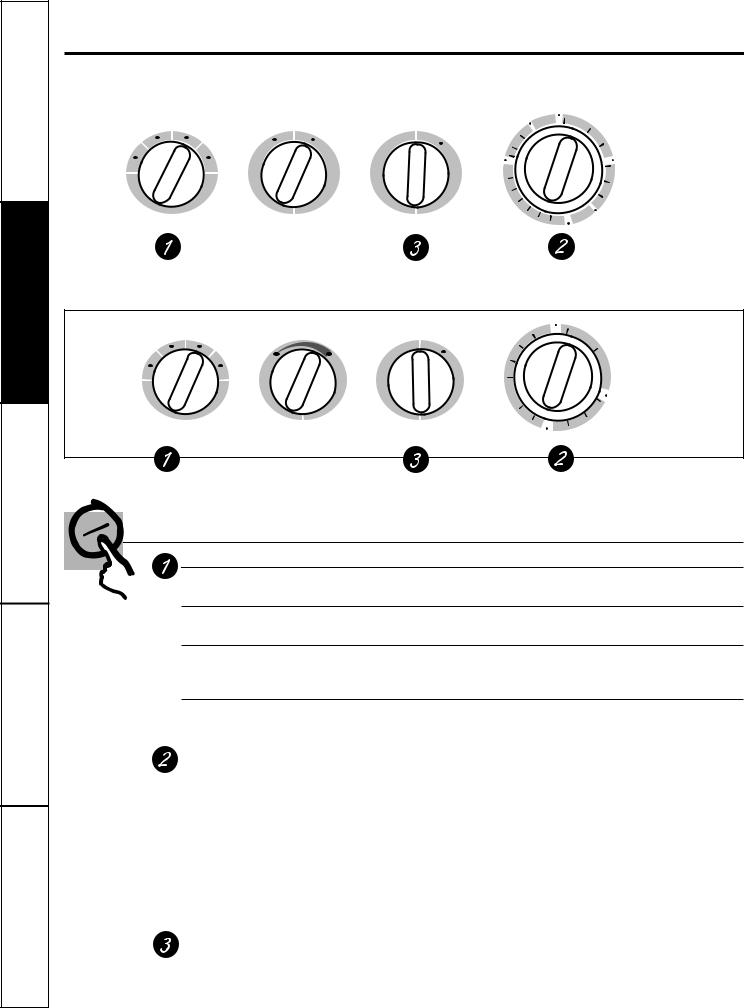
TroubleshootingTips InstallationInstructions Operating Instructions SafetyInstructions
CustomerService
About the dryer control panel.
Model DPXH46
FABRIC CARE |
WRINKLE CARE |
START |
EASY CARE |
WRINKLE |
|
MORE DRY |
COTTONS |
||
CARE |
|
|
|||||||
|
|
EXTENDED COOL AIR TUMBLE |
|
PERM PRESS |
|
|
|
||
|
|
|
|
|
|
OPTIMUM DRY |
|||
PERM PRESS |
KNITS / DELICATES |
|
|
|
|
|
|||
|
|
LESS DRY |
|
|
|
|
|||
MED. HEAT |
LOW HEAT |
ON |
OFF |
|
|
|
|
|
|
|
|
|
ON |
|
|
|
LESS DRY |
||
|
|
|
|
|
|
|
|
||
COTTONS |
|
AIR FLUFF |
|
|
OPTIMUM DRY |
|
|
|
COOL |
|
|
|
MORE DRY |
|
|
|
DOWN |
||
REG. HEAT |
|
NO HEAT |
|
|
|
|
|
|
|
|
|
|
|
|
COOL |
|
|
|
MORE |
|
|
|
|
|
|
|
|
DRY |
|
|
|
|
|
|
DOWN |
|
|
|
|
|
|
|
|
|
10 |
|
|
|
OPTIMUM |
|
|
|
|
|
|
|
|
|
|
|
|
|
|
|
20 |
|
|
|
DRY |
|
|
|
|
|
|
|
|
|
|
|
|
|
|
|
30 |
|
|
|
LESS DRY |
|
|
|
|
|
|
|
|
|
|
|
|
|
|
|
TIMED DRY |
40 |
|
|
WRINKLE CARE |
|
|
|
|
|
50 |
60 |
|
DELICATES |
|
|
|
|
|
|
|
|
|||
|
|
|
|
|
|
|
|
|
|
|
|
|
|
|
|
|
|
|
|
Models DSXH43, DH43, and PSXH43
FABRIC CARE |
CYCLE SIGNAL |
|
START |
COOL |
START EASY CARE |
|
|
DOWN |
|||||
|
|
|
|
|
10 |
PERM PRESS |
PERM PRESS |
KNITS / DELICATES |
|
|
|
TIMED DRY |
|
|
|
|
20 |
DELICATES |
||
MED. HEAT |
LOW HEAT |
|
|
ON |
EXTENDED |
|
|
|
OFF |
LOUD |
|
|
COOL DOWN |
COTTONS |
AIR FLUFF |
|
|
|
30 |
|
REG. HEAT |
NO HEAT |
|
|
|
|
|
|
|
|
|
|
40 |
|
50
MORE DRY
60
OPTIMUM DRY
70 |
COTTONS |
|
COOL DOWN LESS DRY |
||
|
Features and appearance may vary.
Control Settings
Fabric Care
COTTONS For regular to heavy cottons.
REG. HEAT
PERM. PRESS For synthetics, blends and items labeled permanent press or tumble dry medium heat.
MED HEAT
KNITS/ For knits, delicates, synthetics and items labeled tumble dry low heat.
DELICATES
LOW HEAT
AIR FLUFF For fluffing items without heat. Use the TIMED DRY cycle.
NO HEAT
Drying Cycles
The COTTONS, EASY CARE and DELICATES cycles automatically sense fabric dryness. Select MORE DRY for heavier fabrics, LESS DRY for lighter fabrics. The TIMED DRY cycle will run for a selected time.
COTTONS |
For cottons and most linens. For most loads, select the Optimum Dry setting (on some models). |
EASY CARE |
For wrinkle free, permanent press and delicate items, and knits. For most loads, select the |
|
Optimum Dry setting (on some models). |
|
|
DELICATES |
For delicates and special care fabrics. For most loads, select the Optimum Dry |
|
setting (on some models). |
TIMED DRY |
Set the Cycle Selector at the desired drying time. |
|
|
Start
|
Turn the START knob clockwise to ON. Hold for 1–2 seconds and release. Opening the door during |
|
operation will stop the dryer. To restart the dryer, close the door, turn the START knob clockwise to |
6 |
ON, hold for 1–2 seconds and release. |
|
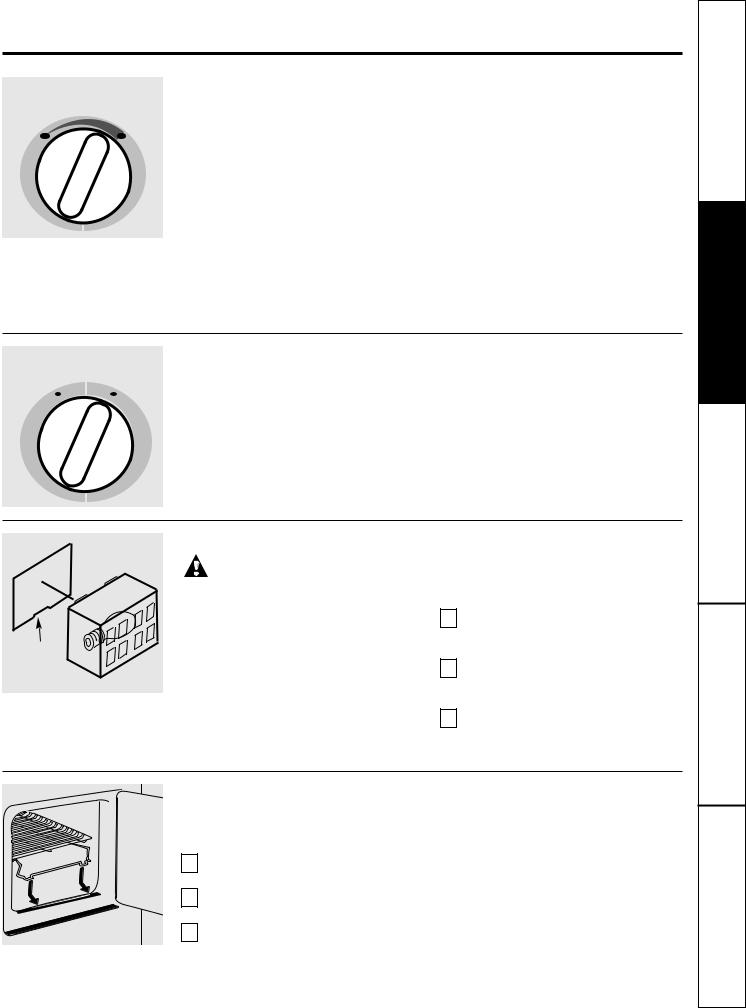
About your dryer features.
CYCLE SIGNAL
OFF |
LOUD |
Cycle Signal Option (on some models)
When the signal is on it will sound just before the end of the cycle to remind you to remove the clothes. The signal can be set at OFF (no sound), LOUD or anywhere in between.
If the dried load cannot be removed promptly during the EASY CARE cycle, the Cycle Selector will advance to the
EXTENDED COOL DOWN setting. Unheated tumbling continues during EXTENDED COOL DOWN and WRINKLE CARE (on some models) for 40 minutes to help reduce wrinkling. When the CYCLE SIGNAL is on, it will sound briefly every
five minutes as a reminder to remove the load.
NOTE:
■If items are removed before the end of the cycle, turn the CYCLE SELECTOR knob to OFF.
■Remove garments promptly at the sound of the signal. Place clothes on hangers so wrinkles won’t set in.
■Use the Cycle Signal especially when drying fabrics like polyester knits and permanent press. These fabrics should be removed so wrinkles won’t set in.
WRINKLE CARE
EXTENDED COOL AIR TUMBLE
ON |
OFF |
Wrinkle Care Option (on some models)
Use this option to minimize the wrinkles in clothes. It provides approximately 15 minutes of no-heat tumbling after the clothes are dry.
This option can only be used with the EASY CARE and DELICATES cycles.
Replacing the Dryer Light Bulb (on some models)
Light cover
Pry with flat blade
screwdriver Light housing
WARNING: To reduce the risk of electric shock, disconnect this appliance from the power supply before attempting any user maintenance. Turning the controls to the OFF position does not disconnect this appliance from the power supply.
The dryer light is located above the dryer door opening.
Before replacing the light bulb, be sure to unplug the dryer power cord or disconnect the dryer at the household distribution
panel by removing the fuse or switching off the circuit breaker.
To replace the dryer light:
1 Using a small flat blade screwdriver, pry the bottom of the light cover out and off the light housing.
2 Unscrew the bulb when cool and replace it with an appliance bulb of the same or lower wattage.
3 Snap the light cover back on the light housing.
Drying Rack (on some models)
A handy drying rack may be used for drying articles such as stuffed toys, pillows or washable sweaters.
1 Remove the lint screen.
2 Place the front bar under the lip of the lint screen opening.
3 When items are dry, remove the rack and replace the lint screen. DO NOT
OPERATE THE DRYER WITHOUT THE LINT SCREEN IN PLACE UNLESS THE DRYING RACK IS IN PLACE.
NOTE:
■The drying rack must be used with the
TIMED DRY cycle.
■Do not use this drying rack when there are other clothes in the dryer.
7
Tips Troubleshooting Instructions Installation Instructions Operating Instructions Safety
Service Customer
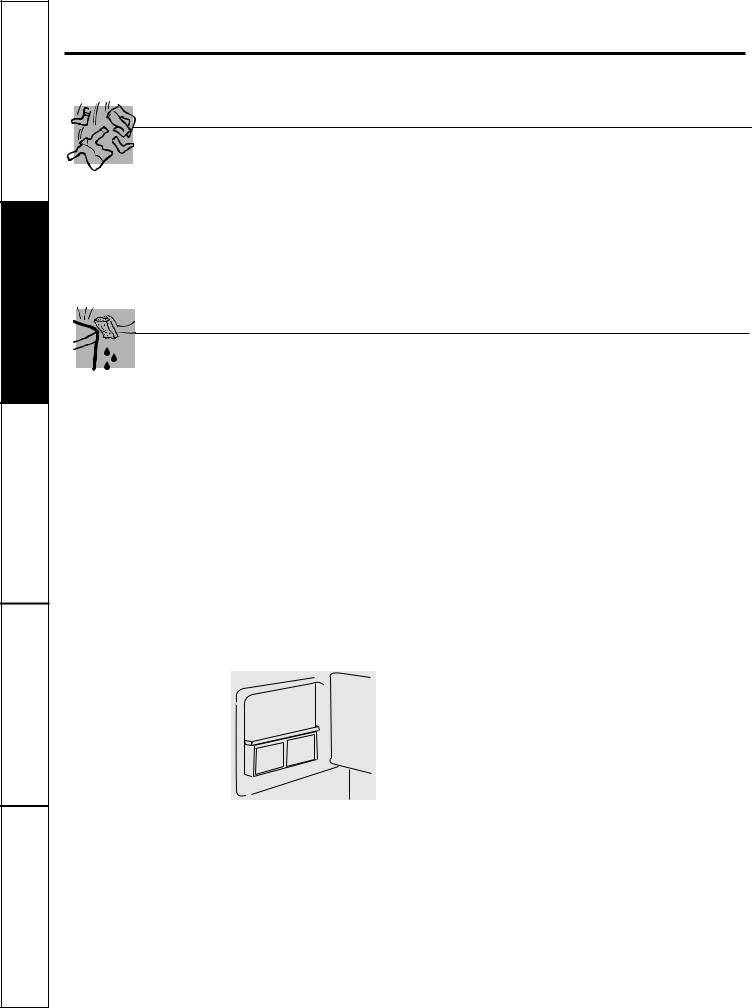
TroubleshootingTips InstallationInstructions Operating Instructions SafetyInstructions
CustomerService
Loading and using the dryer.
Always follow the fabric manufacturer’s care label when laundering.
Sorting and Loading Hints
As a general rule, if clothes are sorted properly for the washer, they are sorted properly for the dryer.
Do not add fabric softener sheets once the load has become warm. They may cause fabric softener stains. Bounce® Fabric Conditioner Dryer Sheets have been approved for use in all GE Dryers when used in accordance with the manufacturer’s instructions.
Do not overload. This wastes energy and causes wrinkling.
Do not dry the following items: fiberglass items, woolens, rubber-coated items, plastics, items with plastic trim and foam-filled items.
Care and Cleaning of the Dryer
The Exterior: Wipe or dust any spills or washing compounds with a damp cloth. Dryer control panel and finishes may be damaged by some laundry pretreatment soil and stain remover products. Apply these products away from the dryer. The fabric may then be washed and dried normally. Damage to your dryer caused by these products is not covered by your warranty.
The Lint Screen: Clean the lint screen before each use. Lint build-up in the screen restricts air flow, which causes longer drying times. The screen is located at the bottom of the door opening. Remove by pulling straight up. Remove the lint and replace the screen.
A waxy build-up may form on the lint screen from using dryer-added fabric softener sheets. To remove this build-up, wash the lint screen in warm, soapy water. Dry thoroughly and replace. Do not operate the dryer without the lint screen in place.
The Exhaust Duct: Inspect and clean the exhaust ducting at least once a year to prevent clogging. A partially clogged exhaust can lengthen the drying time.
Follow these steps:
|
Turn off electrical supply by disconnecting the |
|
1 |
||
plug from the wall socket. |
||
|
||
|
Disconnect the duct from the dryer. |
|
2 |
||
|
Vacuum the duct with the hose attachment and |
|
3 |
||
reconnect the duct. |
||
|
The Exhaust Hood: Check with a mirror that the inside flaps of the hood move freely when operating. Make sure that there is not wildlife (birds, insects, etc.) nesting inside the duct or hood.
8
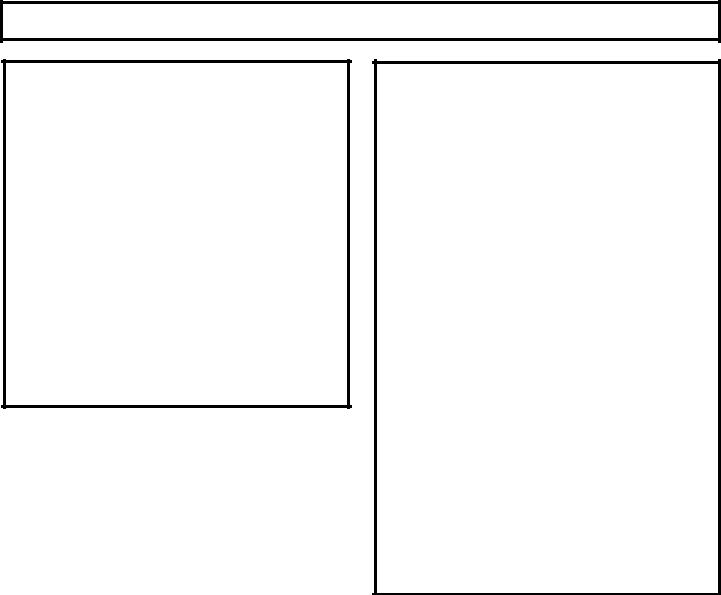
Installation |
Spacemaker Dryer |
Models DXSH43 |
|
Instructions |
DH43 |
|
DPXH46 |
|
PSXH43 |
|
|
Questions? Visit our Website at: www.geappliances.com or Call GE Answer Center at 800.626.2000
BEFORE YOU BEGIN
Read these instructions completely and carefully.
• IMPORTANT – Save these
instructions for local inspector’s use.
• IMPORTANT – Observe all
governing codes and ordinances.
• Note to Installer – Be sure to leave these instructions with the Consumer.
• Note to Consumer – Keep these instructions for future reference.
•Skill level – Installation of this appliance requires basic mechanical and electrical skills.
•Completion time – 1-3 hours
•Proper installation is the responsibility of the installer.
•Product failure due to improper installation is not covered under the Warranty.
FOR YOUR SAFETY:
 WARNING
WARNING
•This dryer must be exhausted to the outdoors using only rigid metal or flexible metal 4″ diameter ductwork for inside the dryer cabinet or exhausting.
•Never use plastic or other combustible ductwork. See
Exhausting section.
•This appliance must be properly grounded and installed as described in these Installation Instructions.
•Do not install or store appliance in an area where it will be exposed to water/weather. See Location of Your Dryer section.
•The National Fuel Gas code restricts installations of gas appliances in garages. They must be 18″ (45.7 cm) off the ground and protected from vehicles by a barrier. See Location of Your Dryer section.
•The electrical service to the dryer must conform with local codes and ordinances and the latest edition of the National Electrical Code, ANSI/NFPA 70 or in Canada, CSA C22.1 Canadian Electrical Code Part 1.
•The gas service to the dryer must conform with local codes and ordinances or the latest edition of the National Fuel Gas Code ANSI Z223.1 or in Canada, CAN/CGA B149.12. The gas dryer is designed under ANSI Z 21.5.1 or ANSI/UL2158–CAN/CSA C22.2 (latest editions) for home use only. This dryer is not recommended for commercial applications such as restaurants or beauty salons, etc.
9
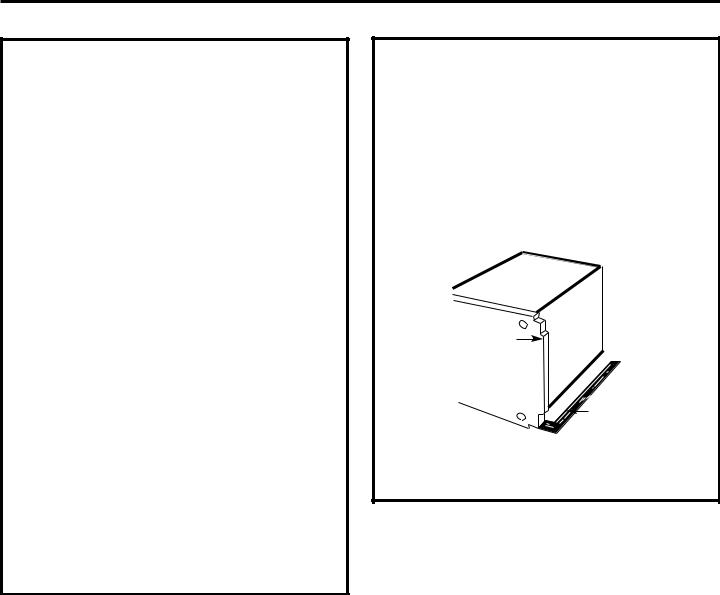
Installation Instructions
TOOLS AND MATERIALS
YOU WILL NEED
•Phillips head screwdriver
•Channel-lock adjustable pliers (adjust leveling legs)
•Carpenter’s level
•Flat or straight blade screwdriver (may be needed for cord strain relief)
•Duct tape
•Rigid or UL-listed flexible metal 4″ (10.2 cm) duct
•Vent hood
•1/4″ nut driver (remove terminal block access cover and install cord) (ELECTRIC DRYER)
•Pipe thread sealer (GAS DRYER)
•Plastic knife
•1/2″ open-end wrench (lock leveling legs)
•UL-listed strain relief (may be supplied with cord)
•UL-listed 30A, 240V, 3-wire, #10 AWG minimum conductor power cord (U.S. existing structure)
•UL-listed 30A, 240V, 4-wire, #10 AWG minimum conductor power cord is required (U.S. new construciton)
•Flexible stainless steel or plastic-coated brass connnecting tube (if allowed by building code)
(GAS DRYER)
•Open-end wrenches for flexible tube and connector
(GAS DRYER)
UNPACKING YOUR DRYER
1.Place the four corner posts from the shipping carton on the floor, parallel to each other, 2-3″ apart. Carefully lay the dryer on its left side on top of the corner posts. Remove the foam shipping pad.
 CAUTION: To prevent damage, do not use the control panel as a means to pick up or move the dryer.
CAUTION: To prevent damage, do not use the control panel as a means to pick up or move the dryer.
Back of
Dryer
Foam shipping pad
Packing
2. Return the dryer to an upright position.
10
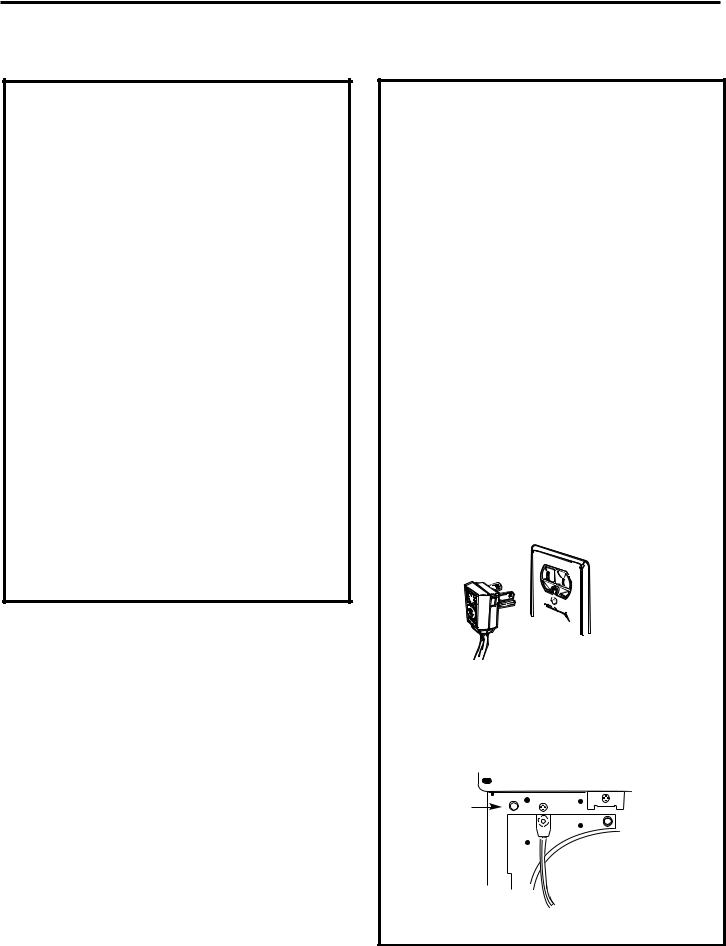
Installation Instructions
Read these instructions completely and carefully.
ELECTRICAL CONNECTION
INFORMATION FOR
ELECTRIC DRYERS
 WARNING – To reduce the risk of fire, electric shock, or personal injury:
WARNING – To reduce the risk of fire, electric shock, or personal injury:
•DO NOT USE AN EXTENSION CORD WITH THIS APPLIANCE.
•THIS APPLIANCE MUST BE PROPERLY GROUNDED.
This dryer must be electrically grounded in accordance with local codes and ordinances, or in the absence of local codes, in accordance with the NATIONAL ELECTRICAL CODE, ANSI/NFPA NO. 70 or in Canada CSA C22.1 Canadian Electrical Code Part 1.
Electrical Requirements
•This dryer must be connected to an individual branch circuit, protected by the required time-delay fuses or circuit breakers. 208V or 240V installation 30 amps.
•Power supply: 3-wire 240 volt, single phase, 60Hz, Alternating Current. (Canada–240 volt, single phase, 60 Hz Alternating Current.)
•Use copper conductors only.
•If the electric supply does not meet the above specifications, call a licensed electrician.
NOTE: A wiring diagram is located under the top panel.
ELECTRICAL CONNECTION INFORMATION FOR GAS DRYERS
 WARNING – To reduce the risk of fire, electric shock, or personal injury:
WARNING – To reduce the risk of fire, electric shock, or personal injury:
•DO NOT USE AN EXTENSION CORD OR AN ADAPTER PLUG WITH THIS APPLIANCE.
•DO NOT, UNDER ANY CIRCUMSTANCES, CUT OR REMOVE THE THIRD GROUNDING PRONG FROM THE POWER CORD.
This dryer must be electrically grounded in accordance with local codes and ordinances, or in the absence of local codes, in accordance with the NATIONAL ELECTRICAL CODE, ANSI/NFPA NO. 70 or in Canada, CSA C22.1 Canadian Electrical Code Part 1.
Electrical Requirements
•This dryer must be supplied with 120V, 60 Hz, and connected to a properly grounded branch circuit, protected by a 15 or 20 amp circuit breaker or time-delay fuse.
•If the electric supply provided does not meet the above specifications, it is recommended that a licensed electrician install an approved outlet.
Ensure proper ground exists before use
External Ground (if required)
An external ground wire (not provided), which meets local codes, may be added by attaching it to the green ground screw on the rear of the dryer in the upper left hand corner, and to grounded metal cold water pipe or other established ground.
Attach ground wire (obtain locally)
NOTE: A wiring diagram is located under the top panel.
11
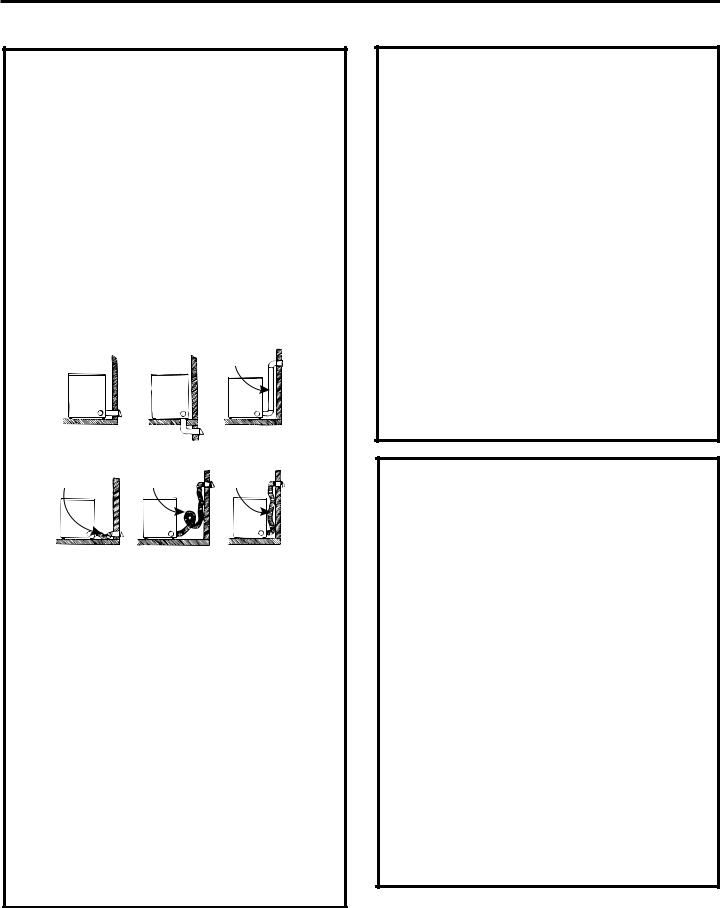
Installation Instructions
EXHAUST SYSTEM
REQUIREMENTS
Use only 4″ (10.2 cm) diameter (minimum) rigid metal duct for best performance, or flexible metal duct, and approved vent hood which has swing-out dampers that open when the dryer is in operation. When the dryer stops, the dampers automatically close to prevent drafts and the entrance of insects and rodents. To avoid restricting the outlet, maintain a minimum of 12″ (30.5 cm) clearance between the vent hood and the ground or any other obstruction.
If all rigid metal duct cannot be used, then flexible allmetal venting can be used, but it will reduce the maximum recommended duct length. See Additional Installation Instructions following.
Correct
Do
Incorrect
Don’t |
Don’t |
Don’t |
 WARNING – The following are specific requirements for proper and safe operation
WARNING – The following are specific requirements for proper and safe operation
of your dryer. Failure to follow these instructions can create excessive drying times and fire hazards.
DO NOT use plastic flexible duct to exhaust the dryer. Excessive lint can build up inside exhaust system and create a fire hazard and restrict air flow. Restricted air flow will increase drying times. If your present system is made up of plastic duct or metal foil duct, replace it with rigid or flexible metal duct. Ensure the present duct is free of any lint prior to installing dryer duct.
If the dryer is not exhausted outdoors, some fine lint will be expelled into the laundry area. An accumulation of lint in any area of the home can create a health and fire hazard.
This dryer exhaust system MUST BE EXHAUSTED TO THE OUTSIDE of the dwelling.
DO NOT allow combustible materials (for example: clothing, draperies/curtains, paper) to come in contact with exhaust system.
 WARNING
WARNING
The dryer MUST NOT be exhausted into a chimney,
a wall, a ceiling, a common duct with a kitchen exhaust or any concealed space of a building which can accumulate lint, resulting in a fire hazard.
DO NOT exceed the length of duct pipe or number of elbows allowed in the Maximum Length charts. Lint can accumulate in the exhaust system, plugging the system and creating a fire hazard, as well as increasing drying times.
DO NOT screen the exhaust ends of the vent system, or use any screws or rivets to assemble the exhaust system. Lint can become caught in the screen, on the screws or rivets, clogging the duct work and creating a fire hazard as well as increasing drying times. Use an approved vent hood to terminate the duct outdoors, and seal all joints with duct tape. All male duct pipe fittings MUST be installed downstream with the flow of air.
EXPLOSION HAZARD. Do not install the dryer where gasoline or other flammables are kept or stored. If the dryer is installed in a garage, it must be a minimum of 18″ (45.7 cm) above the floor. Failure to do so can result in death, explosion, fire or burns.
ADDITIONAL INSTALLATION INSTRUCTIONS
If all rigid metal duct cannot be used, then flexible allmetal venting can be used, but it will reduce the maximum recommended duct length. In special installations when it is impossible to make a connection with the above recommendations, then UL-listed clothes dryer transition duct may be used as transition venting between the dryer and wall connection only. The use of this ducting will affect drying time.
If flexible transition duct is necessary, only UL-listed duct identified for use with clothes dryers is approved.
The following directions must be followed.
•Use the shortest length possible.
•Stretch the duct to its maximum length.
•Do not crush or collapse.
•Never use transition duct inside the wall or inside the dryer.
•Avoid resting the duct on sharp objects.
•Venting must conform to local building codes.
12
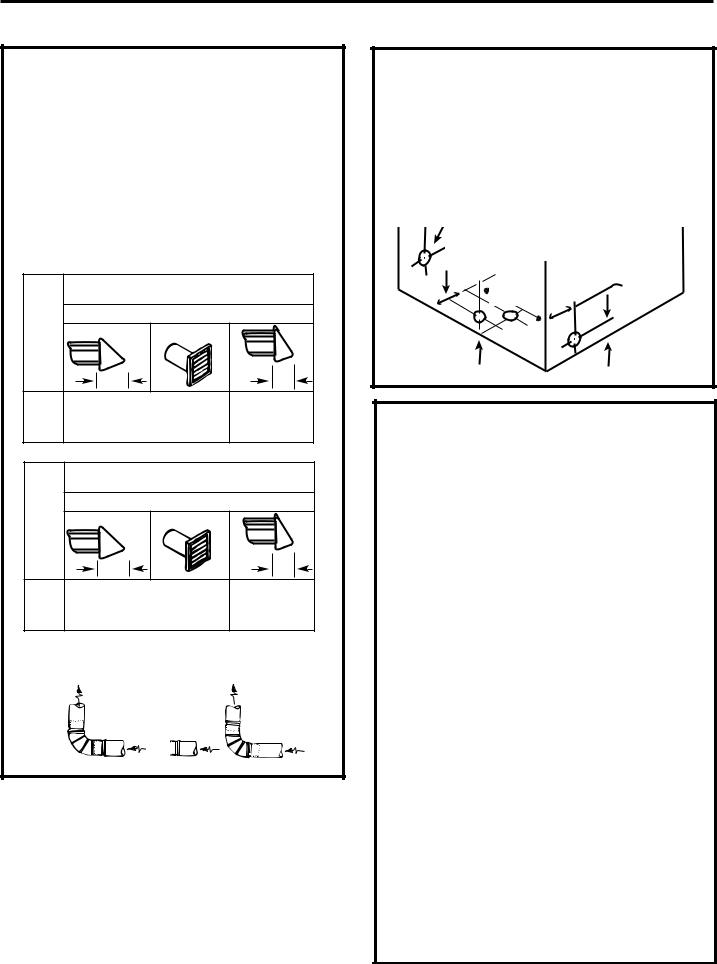
Installation Instructions
EXHAUST DUCTING LENGTH
The exhaust system should be inspected and cleaned a minimum of every year with normal usage. The more the dryer is used, the more often you should check the exhaust system and vent hood for proper operation.
•DO NOT assemble the duct work with fasteners that extend into the duct. They will serve as collection points for lint.
•Insulation—Ductwork which runs through an unheated area or is near an air conditioning duct should be insulated to reduce condensation and lint build-up.
MAXIMUM LENGTH
of 4“ (10.2 cm) Dia. FLEXIBLE METAL TUBING
PREFERRED VENT HOOD TYPE
|
4” (10.2 cm) |
Louvered |
Number |
|
|
of 90° |
|
|
turns |
4” |
2.5” |
|
(6.35 |
|
|
(10.2 cm) |
cm) |
0 |
30’ |
(9.14 m) |
18’ |
(5.49 m) |
1 |
22’ |
(6.71 m) |
14’ |
(4.27 m) |
2 |
14’ |
(4.27 m) |
10’ |
(3.05 m) |
MAXIMUM LENGTH
of 4“ (10.2 cm) Dia. RIGID METAL DUCT
PREFERRED VENT HOOD TYPE
|
4” (10.2 cm) |
Louvered |
Number |
|
|
of 90° |
|
|
turns |
4” |
2.5” |
|
(6.35 |
|
|
(10.2 cm) |
|
|
cm) |
|
|
|
0 |
48’ |
(14.63 m) |
40’ |
(12.19 m) |
1 |
40’ |
(12.19 m) |
32’ |
(9.75 m) |
2 |
32’ |
(9.75 m) |
24’ |
(7.32 m) |
INSTALL MALE FITTINGS IN
CORRECT DIRECTION
CORRECT |
|
|
INCORRECT |
|
|
|
|
EXHAUST DIRECTION
All dryers shipped from the factory are set up for rear exhausting. However, on ELECTRIC DRYERS,
exhausting can be on the right or left side of the cabinet or the bottom of the dryer. On GAS DRYERS, exhausting can be on the right side of the cabinet or the bottom of the dryer. Directional exhausting can be accomplished by installing Exhaust Kit, Pub. No. 14-A018, available through your parts distributor. Follow the instructions supplied with the kit.
Same as EXHAUST DUCT LOCATING |
|
|
other side |
DIMENSIONS |
|
5-7/8″ |
|
|
(15 cm) |
4-3/8″ |
|
|
|
|
13-1/2″ |
|
(11 cm) |
(34 cm) |
|
|
3-3/4″ (9.5 cm) |
|
3-3/4″ (9.5 cm) |
GAS SUPPLY REQUIREMENTS
Replace brass connecting pipe that is not plastic-coated. Stainless steel or plastic-coated brass MUST be used.
 WARNING: Never reuse old flexible connectors. The use of old flexible connectors can cause gas leaks and personal injury. Always use NEW flexible connectors when installing a gas appliance.
WARNING: Never reuse old flexible connectors. The use of old flexible connectors can cause gas leaks and personal injury. Always use NEW flexible connectors when installing a gas appliance.
1.Installation MUST conform with local codes, or in the absence of local codes, with the National Fuel Gas Code, ANSI Z223.1 (latest edition) or in Canada, the current CAN/CGA B149.
2.The gas supply line should be of 1/2″ (1.27 cm) rigid pipe.
3.If codes allow, flexible metal tubing may be used to connect your dryer to the gas supply line. The
tubing MUST be constructed of stainless steel or plasticcoated brass.
4.The gas supply line MUST have an individual shutoff valve.
5.A 1/8″ (0.32 cm) NPT plugged tapping, accessible for test gauge connection, MUST be installed immediately upstream of the gas supply connection to the dryer.
6.The dryer MUST be disconnected from the gas supply piping system during any pressure testing of the gas supply piping system at test pressures in excess of 1/2 psig (3.45 kPa).
7.The dryer MUST be isolated from the gas supply piping system during any pressure testing of the gas supply piping system at test pressures equal to or less than
1/2 psig (3.45 kPa).
13
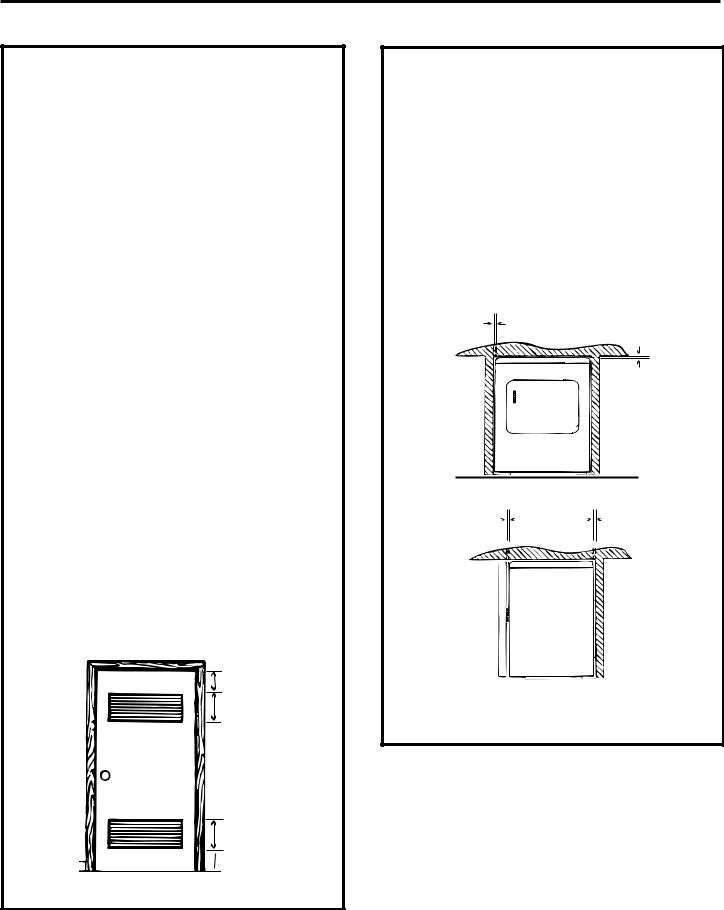
Installation Instructions
LOCATION OF YOUR DRYER
Do Not Install the Dryer:
1.Do not install the dryer in an area exposed to dripping water or outside weather conditions.
2.Do not install the dryer in an area where it will come in contact with curtains, drapes, or anything that will obstruct the flow of combustion and ventilation air.
3.Do not install the dryer on carpet.
Floor MUST be solid with a maximum slope of 1″ (2.54 cm).
Undercounter Installation:
If an undercounter* installation is desired, the dryer MUST have a top sheet kit installed, Pub. No. 14–A008. Kit is available from an authorized parts distributor.
*Custom-sized countertop is required.
Installation in Recess or Closet:
1.A dryer installed in a bedroom, bathroom, recess or closet MUST be exhausted outdoors.
2.No other fuel burning appliance shall be installed in the same closet as the GAS DRYER.
3.Your dryer needs the space around it for proper ventilation. DO NOT INSTALL YOUR DRYER IN A CLOSET WITH A SOLID DOOR.
4.A minimum of 120 square inches (774.2 square cm)
of opening, equally divided at the top and bottom of the door, is required. Air openings are required to be unobstructed when a door is installed. A louvered door with equivalent air openings for the full length
of the door is acceptable.
3 in.
(7.6 cm)
60 sq. in.
(387.1 sq. cm)
60 sq. in.
(387.1 sq. cm)
 3 in.
3 in.
 (7.6 cm)
(7.6 cm)
Closet door
Allow the following clearances for ease of installation:
|
FRONT |
SIDES |
REAR |
TOP |
Alcove or |
0 (0 cm) |
0 (0 cm) |
0 (0 cm) |
0 (0 cm) |
under counter |
|
|
|
|
Closet |
1″ (2.54 cm) |
0 (0 cm) |
0 (0 cm) |
0 (0 cm) |
Closet door ventilation required: 2 louvered openings each 60 square inches (387.1 square cm), located 3″
(7.6 cm) from bottom and top of door.
THIS DRYER MUST BE EXHAUSTED OUTDOORS.
5.The following illustrations show minimum clearance dimensions for proper operation in a recess or closet installation.
0″
(0 cm)
0″
(0 cm)
|
|
|
|
|
|
1″ |
|
|
|
|
0″ |
|
|
|
|
|
|
|
(2.54 cm) |
|
|
|
|
(0 cm) |
|
|
|
|
|
|
|
|
|
|
|
|
|
|
|
|
|
|
|
|
|
|
|
|
|
|
|
|
|
|
|
|
|
|
|
|
|
|
|
|
|
|
|
|
|
|
|
|
|
|
|
|
|
NOTE: Undercounter and stack models—0″ (0 cm) for sides, rear and top
14
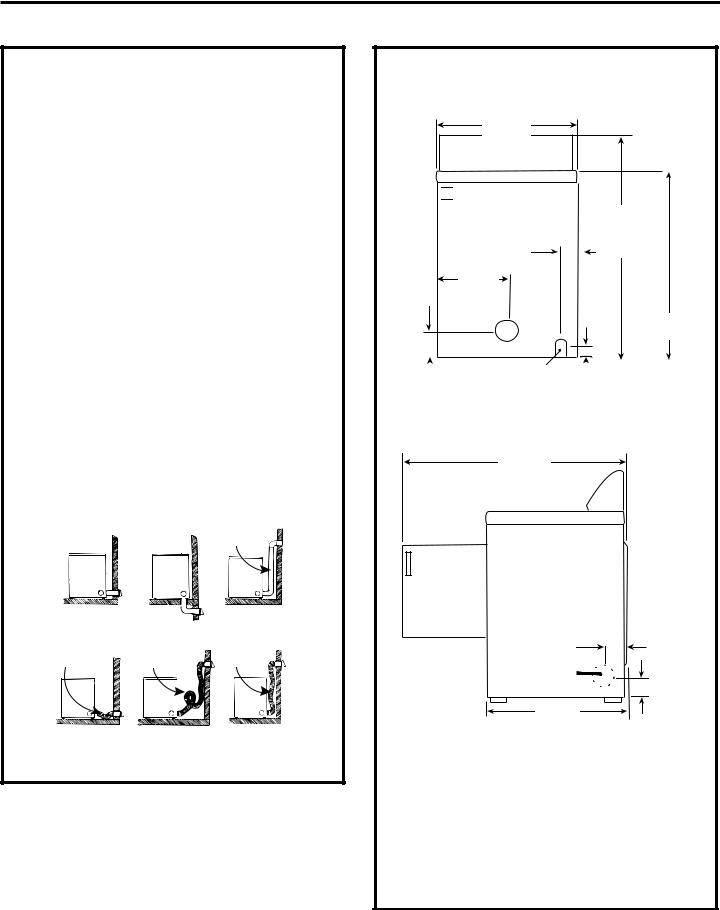
Installation Instructions
MOBILE HOME INSTALLATION
1.Dryer MUST be exhausted outside (outdoors, not
beneath the mobile home) using metal ducting that will not support combustion. Metal ducting must be 4″ (10.16 cm) in diameter with no obstructions. Rigid metal duct is preferred.
2.If dryer is exhausted through the floor and area beneath the mobile home is enclosed, the exhaust system MUST terminate outside the enclosure with the termination securely fastened to the mobile home structure.
3.When installing a gas dryer into a mobile home, a provision must be made for outside make-up air. This provision is to be not less than twice the area of the dryer exhaust outlet.
4.A gas dryer MUST be fastened to the floor. Mobile Home Installation Kit Pub. No. 14–D346–33 is available from your dealer.
5.See the Exhaust System Requirements section for other important venting information.
6.Installation MUST conform to current Manufactured Home Construction & Safety Standard (which is a Federal Regulation Title 24 CFR—Part 32–80) or, when such standard is not applicable, with American National Standard for Mobile Homes. In Canada, the CSA Z240 is applicable.
Correct
Do
Incorrect
Don’t |
Don’t |
Don’t |
The dryer is designed under ANSI Z 21.5.1 for HOME USE only.
ROUGH-IN DIMENSIONS
26 7/8″
(68.3 cm)

 Electrical connection
Electrical connection
Under counter 34 5/8″
2 9/16″ (87.9 cm)
(6.5 cm)
13 1/2″
(34.4 cm)
36″
(91.5 cm)
|
|
|
|
|
3/8″ (0.96 cm) Dia. |
|
|
|
|
|
|
|
|
|
|
|
|
|
|
|
|
|
|
|
|
1″ (2.54 cm) |
|||
3 3/4″ |
gas pipe |
|
|||||||
|
|
|
|
|
|||||
(9.5 cm) |
|
|
|
|
|
||||
REAR VIEW
47 1/2″
(120.7 cm)
3/4″ (1.9 cm)
Door open 90˚
4 3/8″ |
|
(11.1 cm) |
|
Optional |
|
vent knockout |
|
27″ |
|
(68.6 cm) |
3 3/4″ |
|
|
|
(9.5 cm) |
SIDE VIEW
SERVICING—Consideration must be given to provide adequate clearances for installation and servicing.
 CAUTION—Label all wires prior to disconnection when servicing controls. Wiring errors can cause improper and dangerous operation (verify proper operation after servicing/installation).
CAUTION—Label all wires prior to disconnection when servicing controls. Wiring errors can cause improper and dangerous operation (verify proper operation after servicing/installation).
15
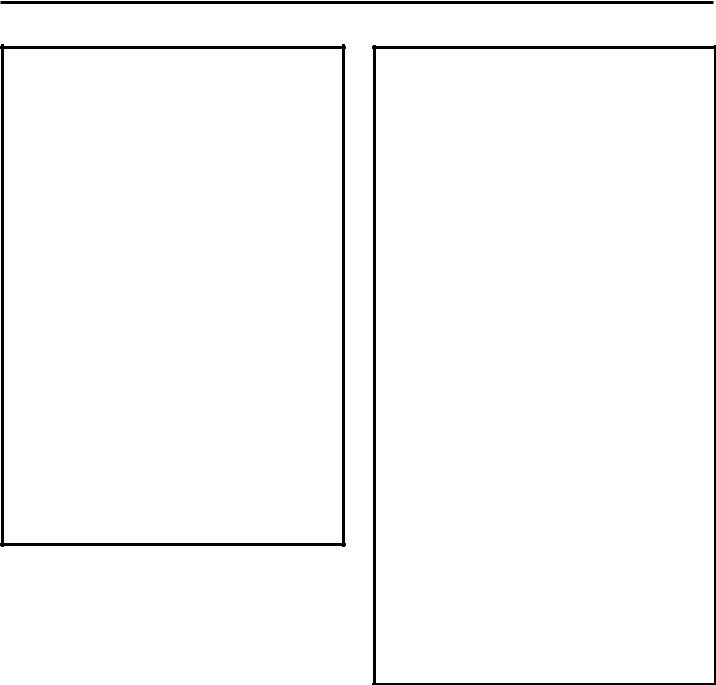
Installation Instructions
ELECTRICAL INSTALLATION FOR ELECTRIC DRYERS
 WARNING: The following are specific requirements for proper and safe electrical installation of your dryer. Failure to follow these instructions can create electrical shock and/or a fire hazard.
WARNING: The following are specific requirements for proper and safe electrical installation of your dryer. Failure to follow these instructions can create electrical shock and/or a fire hazard.
This appliance MUST be properly grounded. Electrical shock can result if the dryer is not properly grounded. Follow the instructions in this manual for proper grounding.
DO NOT use an extension cord with this dryer. Some extension cords are not designed to withstand the amounts of electrical current this dryer utilizes and can melt, creating electrical shock and/or fire hazard. Locate the dryer within reach of the wall outlet, taking into account the length of power cord to be purchased and allowing some slack in the cord. Refer to Electrical Requirements in this manual for the proper power cord to be purchased.
A UL-listed strain relief must be installed onto power cord. If the strain relief is not attached, the cord can be pulled out of the dryer and can be cut by any movement of the cord, resulting in electrical shock.
NOTE: Dryers operating on 208-volt power supply will have longer drying times than those operating
on 240-volt power supply.
A wiring diagram is located under the top panel.
GROUNDING REQUIREMENTS
 WARNING: Improper connection of the equipment-grounding conductor can result in a risk of electric shock. Check with a licensed electrician if you are in doubt as to whether the appliance is properly grounded.
WARNING: Improper connection of the equipment-grounding conductor can result in a risk of electric shock. Check with a licensed electrician if you are in doubt as to whether the appliance is properly grounded.
The dryer MUST be grounded. In the event of a malfunction or breakdown, grounding will reduce the risk of electrical shock by creating a path of least resistance for electrical current.
Grounding must be in accordance with local codes and ordinances, or in the absence of local codes, in accordance with the National Electrical Code ANSI/NFPA No. 70.
For a grounded, cord-connected electric dryer:
If your dryer is equipped with a power supply cord having an equipment-grounding conductor and a grounding plug, the plug MUST be plugged into an appropriate, copper-wired receptacle (in the U.S.), or in Canada, an appropriate outlet, that is properly installed and grounded in accordance with all local codes and ordinances. If in doubt, call a licensed electrician.
For a permanently-connected electric dryer:
•The dryer MUST be connected to a grounded metal, permanent wiring system; or an equipment-grounding conductor must be run with the circuit conductors and connected to the equipment-grounding terminal or lead on the appliance.
For a grounded, cord-connected gas dryer:
•This dryer is equipped with a three-prong (grounding) plug for your protection against shock hazard and should be plugged directly into a properly grounded threeprong receptacle. Do not cut or remove the grounding prong from this plug. Do not modify the plug on this appliance. If it will not fit the outlet, have a proper outlet installed by a qualified electrician.
16
